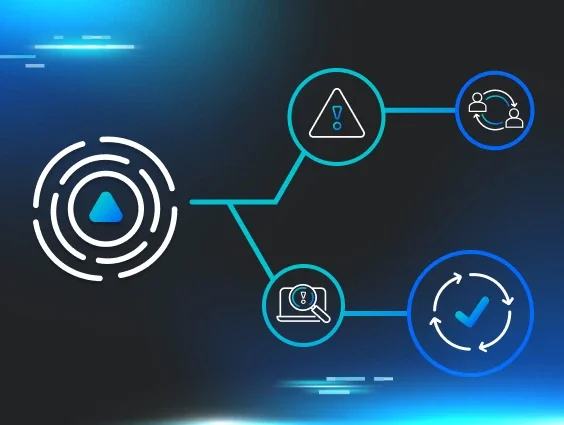
One of the most effective ways to stop a cyberattack is to implement a security awareness training program. Every employee, from the C-suite to the interns, needs to know how to spot a suspicious email, where to report it, and why it’s so critical.
But a strong security culture goes beyond just identifying phishing emails. Employees need to be knowledgeable about a whole host of other security topics, like ransomware, password hygiene, and information security. The list is long, and many organizations don’t know where to start.
Every single employee needs the skills to defend themselves—and your business—against threat actors. In this article, we’ll break down the essential components for building a strong cybersecurity culture in your organization.
What is a security awareness training program?
A security awareness training program is a formal process for educating employees about cybersecurity best practices and corporate policies. The primary purpose is to empower employees to protect sensitive information and defend against cyber threats.
Think of it this way: without a formal program, you're just hoping employees know what to do. A comprehensive training program does more than just run phishing tests; it provides ongoing education and engaging content that builds a baseline of security knowledge across your organization.
Your employees are the first line of defense. By fostering a culture of security through training, you empower them to protect the business. The value of security training is immense—organizations spend far more time, money, and resources cleaning up after a data breach than they do preventing one.
15 must-have components of an effective behavior security awareness training program
Ready to build a program that actually works? Here are the 16 essential components every security awareness training program should include.
1. Engaging training content
If you want employees to retain what they learn, the content has to be fun and relatable. Ditch the "death by PowerPoint" presentations. Your employees should walk away saying they actually enjoyed the training.
Implementation guidance:
Topics: Cover modern cyber threats like phishing, social engineering, ransomware, password security, and multi-factor authentication (MFA).
Format: Use a mix of videos, interactive quizzes, realistic phishing simulatoins, and hands-on learning experiences.
Message: Clearly explain why security awareness is so important for the organization and for them personally.
2. Realistic phishing simulator
Phishing simulations are one of the most effective ways to assess the impact of your training. The 2025 Verizon Data Breach Investigations Report reveals that 60% of data breaches involve the human element, including phishing attacks, highlighting the critical need for continuous employee education.
Implementation guidance:
Frequency: Run phishing tests at least monthly.
Relevance: Use templates that mimic real-world phishing scams and tradecraft.
Goal: Train employees in a safe environment, allowing them to learn from their mistakes without real-world consequences.
3. A simple way to report phishing
Employees need a one-click solution to report suspicious emails. Whether they're on a desktop or a mobile device, the process should be simple and consistent. This allows your IT security team to be notified immediately and respond to potential company-wide threats.
4. Learning Management System (LMS)
You need a centralized system to record, track, and distribute training content to all employees, including contractors. A good LMS eliminates the need for messy spreadsheets and helps you organize your training efforts efficiently.
Implementation guidance:
Most security awareness vendors include an LMS in their platform.
Use the LMS to generate compliance reports for auditors, demonstrating the results and completion rates of your program.
5. Automated notifications & reminders
Stop chasing down individual employees. A solid security awareness platform should automate training notifications and reminders.
Implementation guidance:
Set up an automated email or messaging system "nudges" for employees who haven't completed their required courses.
Include email or messaging system “nudges” for managers who have direct reports with incomplete assignments.
Customize the timing and frequency of these notifications to fit your company culture.
6. Accessible security policies
Security policies provide formal guidance on how your organization expects employees to handle security protocols. Without clear policies, employees are left guessing.
7. Supplemental downloads & resources
Reinforce your training with key takeaways. These resources are supplemental to your training topics and serve as a fun reward. Think phishing defense guides, security-themed desktop wallpapers, or checklists.
8. Employee incentives, recognition, and gamification
Don't just focus on employees who struggle. Celebrate your security heroes! Rewarding well-behaved employees can be a powerful motivator. Including badges, streaks, and leaderboards is another way to increase learner motivation and reward positive security-aware behaviors.
Implementation guidance:
Incentives: Consider extra office competitions, public recognition from the CEO, rewards, or charity donations in their name.
Focus: Acknowledge team members who complete training promptly and excel at spotting simulated phishes.
9. Executive support
Your program needs executive buy-in to succeed. In fact, learners list manager encouragement as their #1 reason for completing their training. If leadership doesn't support a security-first culture, it signals that they don't fully grasp their role in risk management. Leaders must identify risks, develop strategies, and champion the action plans needed to protect the business.
10. A strategic rollout plan
You can't launch a program successfully without a solid plan.
Implementation guidance:
Announcement: How will you announce the new training? An all-hands meeting is often more impactful than a simple email.
Frequency: Security training isn't a one-and-done event. Plan for continuous content rollouts to keep security top-of-mind.
11. Clear goals & metrics
You can't improve what you don't measure. Set clear goals to track the growth and success of your program.
Implementation guidance:
Metrics to Track: Start with completion rates, phishing report rates, quiz scores, and a reduction in clicks on simulated phishing emails. Once your program matures to a Human Risk Management approach, you can begin to look at other risk metrics outside of these.
Purpose: These goals should be designed to communicate the success and ROI of your program to leadership.
12. A continuous feedback loop
Getting feedback from your employees is essential. Hearing directly from them will help you understand what’s working and what isn’t. Don't treat your program as a one-way street; use these insights to continuously improve.
13. Personal motivation
How do you get employees to want to participate? Connect with them on a personal level. Show them how a lack of security hygiene can impact them directly—for example, how their personal bank account could be drained if they don't use MFA. Follow this up with training that isn’t painful for them to sit through. Instead, utilize short, engaging training on a frequent (think monthly) basis.
14. Internal security ambassadors
Create a security influencer group within your organization. These aren't necessarily managers; they're the people who are charismatic, respected, and trusted by their peers. This group can help drive company-wide buy-in and make security a core part of your culture.
15. Security-themed events
Create unique events that support your security awareness campaigns and help to promote your internal security culture.
Implementation guidance:
Ideas: Host a "Password Day" with a game to see who can crack weak passwords, or a "Two-Factor Tuesday" to ensure everyone has MFA enabled on their accounts.
Goal: Make security best practices interactive and memorable.
FAQ about Security Awareness Training Programs
1. Why is security awareness training important for employees?
It transforms your employees from potential targets into your first line of defense. Training empowers them to recognize and thwart cyberattacks, which, according to a report from Stanford University, are caused by human error in 88% of cases. This reduces organizational risk and protects sensitive data.
2. What are the goals of an awareness training platform for security behavior change?
The primary goals are to change employee behavior to reduce human risk levels, build a strong security culture, and meet regulatory compliance requirements. Ultimately, the objective is to minimize security incidents caused by human error.
3. How does a security training program reduce human risk?
By educating employees on how to identify threats like phishing, malware, and social engineering, you reduce the likelihood of a successful attack. A trained employee is less likely to click a malicious link, download a harmful attachment, or divulge sensitive information.
4. What types of security training programs are available?
Programs come in several formats:
Online/E-learning: Scalable, self-paced modules.
In-Person: Live, instructor-led sessions for interactive learning.
Hybrid: A combination of online modules and in-person workshops.
5. What topics should a security training program cover?
A comprehensive program should cover phishing, ransomware, password security, social engineering, safe browsing, physical security, data handling, emerging threats and trends like AI, and the importance of multi-factor authentication (MFA).
6. Should training include phishing simulations?
Absolutely. Phishing simulations are a critical tool for assessing employee vulnerability in a safe, controlled environment and reinforcing learned behaviors. They provide practical, hands-on experience and an opportunity to coach learners who’ve taken a risky action.
7. How often should employees undergo security training?
Security training should be continuous, not a one-time event. It is recommend to conduct training ongoing a monthly basis along with monthly phishing simulations to keep security top-of-mind.
8. Does the training cover compliance requirements (e.g., HIPAA, GDPR, PCI-DSS)?
Many security awareness platforms offer specialized content to help organizations meet specific compliance requirements. When selecting a vendor, ensure they provide training relevant to the regulations governing your industry.
Ready to build a better security awareness program?
Running a security awareness program requires participation from everyone, but you're not in this alone. Huntress takes most of this work off your plate, acting as an extension of your team.
We make security awareness training fun, engaging, and inclusive. See for yourself by signing up for a free trial and learn how we can help you build a stronger security culture.
















